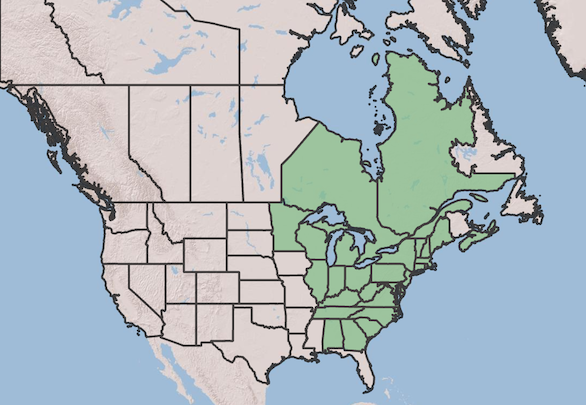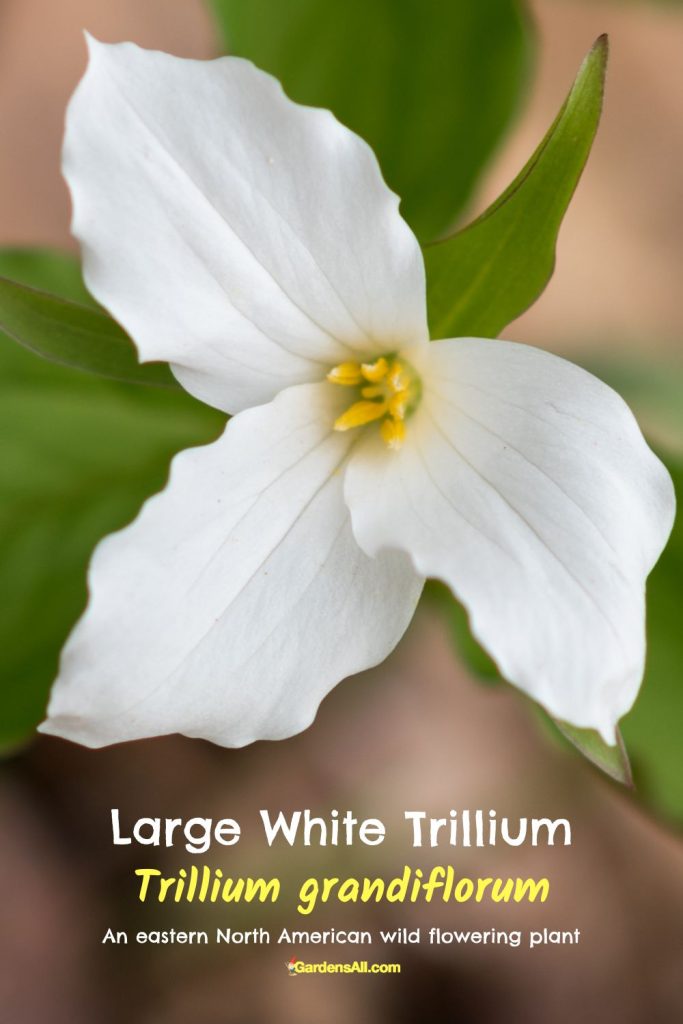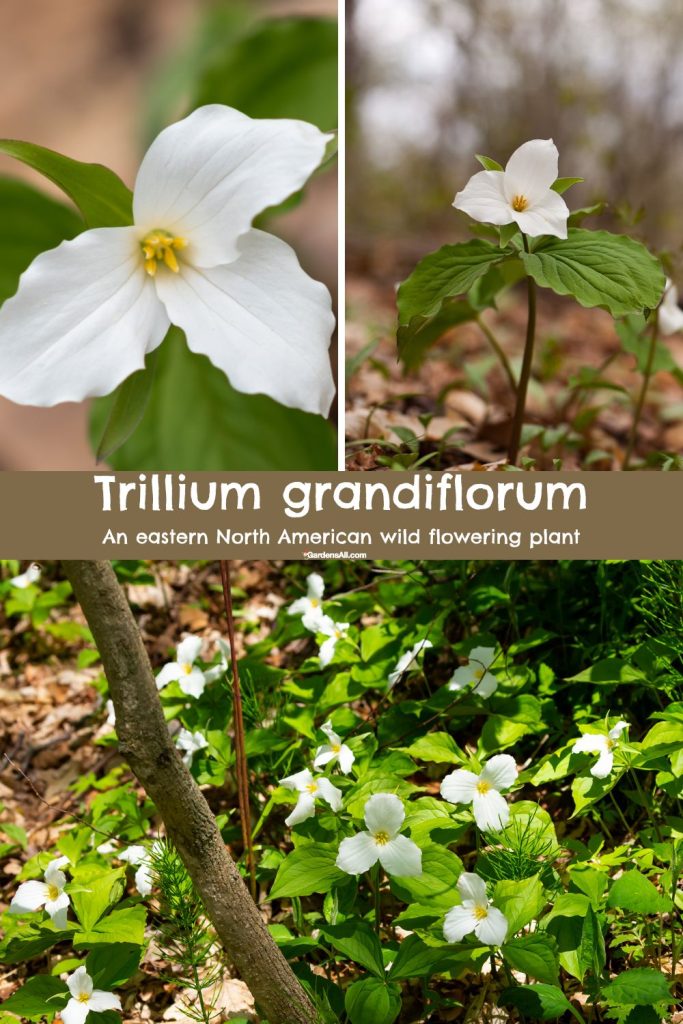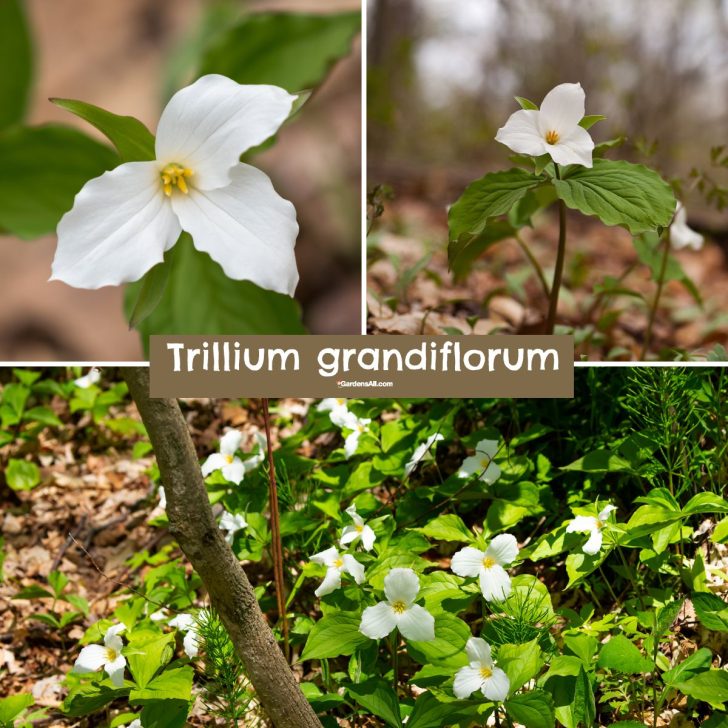Trillium grandiflorum, is a perennial spring-flowering plant in the Trillium genus, and the liliaceae family, is generally hardy in zones 5-8. Native to eastern North America, White Trillium is found in woodlands, meadows, and along streams from Ontario, Canada, south to Georgia, USA.
In fact, white trillium is the official flower of Ontario, Canada

White Trillium Grandiflorum Names
Scientific Names
- Family – Liliaceae (Lily), from the Latin, Lilium, which is from the Greek word, leirion, meaning “true”
- Genus – Trillium, from Latin trilix, meaning “triple”
- Species – grandiflorum, Latin, for large, showy flowers.
Common Names for Trillium Grandiflorum
- great white trillium – due to the large size and color of the flowers
- large-flowered wake-robin
- large white trillium – are among the largest of all trillium species
- white trillium
- white wake-robin: in reference to the plant’s springtime bloom time
What Does Trillium Grandiflorum Look Like?
The white trillium is one of the largest in the Trillium family, thus the name “large” and “grandiflorum” for grand/large flower.
What is White Trillium’s Size?
Trillium grandiflorum is an herbaceous perennial plant that grows up to 12-18 inches (30-45 cm) tall, so this list is an average of the ranges, give an inch or two.
- Height: ~15 inches (38 cm) tall
- Girth: ~12 inches (30 cm) around
- Leaves: ~6 (15 cm) long
- Flowers: ~3.5 inches (9 cm) in diameter
White Trillium Appearance
You’ll understand the origin of the Trillium name when you see the dominance of 3:
- Stem – single stem
- Leaves – 3 large oval shaped leaves that are solid green and smooth
- Petals – 3 large oval shape white flower petals
- Bracts – 3 small pointed bracts
- Center – yellowish green center:
- stamen – yellow stamen
- ovary – green center
The plant has a single stem that supports three large, oval-shaped leaves, that are whorled around the stem. The leaves are green and smooth, and can grow up to 15 cm (6 inches) long.
Trillium Flowers
In spring, Trillium grandiflorum produces a single, large white flower that measures up to 3-4 inches (8-10 cm) in diameter. The flower has three petals that are broad and slightly curved, with a central yellow-green ovary. The petals may have pink or reddish tinges on the undersides.
White trillium generally blooms from March to June, depending on the regional climate.

Growing Conditions
Trillium grandiflorum prefers a cool, moist, woodland environment with well-draining, humus-rich soil. It loves the scattered sun of a woodland setting, and does all its growing in spring before the tree canopy darkens the forest floor, similar to the ramp vegetable.
Propagation
You can be propagate Trillium from seed, but may take several years to flower. So it’s best to propagate via division or rhizome.
Established plants can also be divided every few years, either in the fall after flowering or in early spring before new growth begins.
White Trillium Uses
Edible Uses
Trillium leaves are edible fresh in salad or cooked like spinach, and are said to taste similar to sunflower seeds. That’s good to know as a possible survival food, but for everyday foraging fare, it’s a waste of a plant to take what little foliage it has when there are so many other plant with an abundance of edible leaves.
Ornamental Uses
Trillium grandiflorum is a popular ornamental plant in woodland gardens and shade gardens. It is often used in native plant landscapes or naturalistic settings, and is known for its large, showy flowers.
Medicinal Uses
The plant has also been used in traditional medicine to treat a variety of ailments, including menstrual cramps, gastrointestinal disorders, and skin conditions. However, with only three leaves, three petals and one rhizome per plant, harvesting a trillium will kill it. So use of other more readily available herbs is recommended.
You may also enjoy this article on Sweet Betsy Trillium, (T. cuneatum).
Conservation Status of Trillium Grandiflorum
White trillium is considered a vulnerable species in some areas, particularly in Ontario, Canada, where it is protected under the province’s Endangered Species Act.
Over-collecting and habitat destruction are the main threats to the plant’s survival. So harvesting trillium from the wild is not recommended, but these days, you can find any trilliums for sale in nurseries and online.

EDITOR’S NOTE: We haven’t grown this Trillium ourselves, nor do we have it growing in our woods like the Sweet Betsy Trillium. We have only researched it but could not find conclusive information on the T. grandiflorum scent. If you know about this from personal or professional experience, we’d very much appreciate hearing from you.
I’m LeAura Alderson, a garden, herb and plant enthusiast with a passion for discovering the many edible and medicinal benefits of the plants all around us, including the weeds! I’m a writer, editor and media publisher for our family of websites.
While I was certified in fitness and life coaching, I am NOT a health practitioner. However, I’m a lifelong health enthusiast, with a keen interest in healthy, organic foods and making home remedies and the content we share is from our own experience and usage as well as that extracted from scientific research so that you can explore further on your own.
Always seek the advice and guidance of your health practitioners first and foremost.
As a family we’re steadily expanding our gardening, experimentation and knowledge around all things gardening, edible landscaping, fresh organic foods and self sustainability with farming in our future. I also own and manage iCreateDaily.com, a site all about transformation through creation, and the power of positivity, optimism and mindset.

